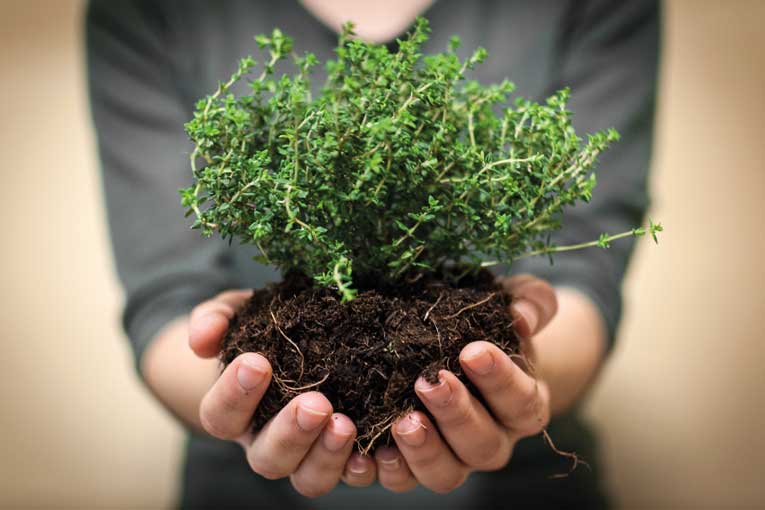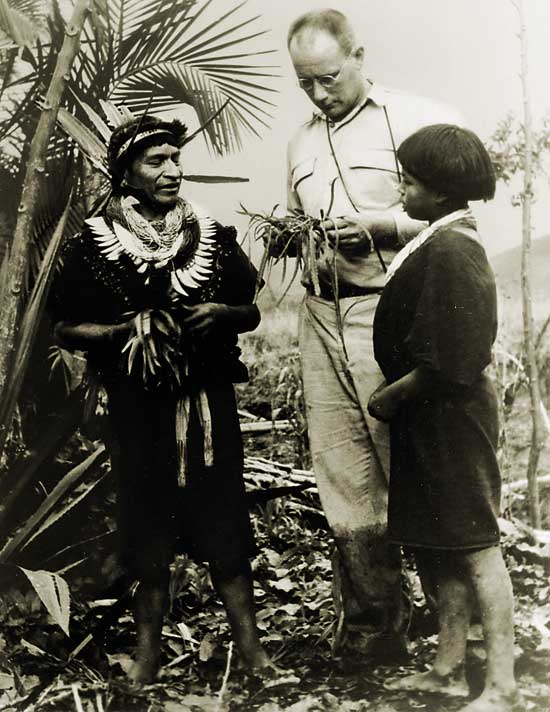
| ABSTRACT Ethnobotany, a discipline located at the intersection between natural science and social science, is sometimes misunderstood by researchers from one or other of these fields. In this article we discuss the positive and negative aspects of interdisciplinarity regarding this subject, and we argue for its status as a true science from different points of view. Our conclusion is that ethnobotanical research – like all ethnobiological research in general – undoubtedly exists within the scientific field and is successfully established, active and productive. In addition, ethnobotany is a citizen science: the participation of the population is essential for research, which must be communicated to academia and to the general citizen. Keywords: ethnobiology, ethnobotany, citizen science, natural science, social science, multidisciplinarity. |
||
| In memory of Pius Font i Quer, pioneer in the development of Catalan ethnobotany as a scientific discipline. |
||
Ethnobotany is a compound word, immediately indicating an approach to the subject matter from different points of view. Intuitively, one makes the connection with human groups and plants (the objects of study of ethnology and botany, respectively). This causes a situation that many other scientific disciplines do not have to consider, for two main reasons. On the one hand, individuals are involved in the discipline in two different ways: as scientists who carry out research projects and as informants who provide observation results (sometimes an individual can even be the scientist who creates the ethnobotanical surveys and the informant who answers them). On the other hand, the use of methods from both social and natural sciences in ethnobotanical practice makes it particular, because it can involve collaboration between scientists from different fields (sometimes completely unknown to each other) or the training of scientists from one field in other disciplines. Ethnobotany (and related disciplines, such as general ethnobiology; ethnomycology, which has become closely linked with matters of the mind; ethnoecology or ethnopharmacology, dealing with the three classical realms of nature – animal, plant and mineral – but focused on ecological and pharmaceutical aspects, respectively) has been practised for a very long time and, especially in recent times, in many parts of the world. In Europe and in the Iberian Peninsula, close to the geographic area of this journal, we have witnessed an extensive and interesting bibliography on the topic in recent years (see, for example, Pardo de Santayana, Pieroni, & Puri, 2010, and the numerous references found in this book, and Pardo de Santayana, 2014). From the local to the international level, we find many publications with documents on the discipline (among them Mètode, which devoted a monograph to ethnobotany in issue 72, and some others we will mention later. EIn this article, we do not want to provide and analyse new ethnobotanical data, nor make a basic presentation of the subject and its implications for other fields of science, such as, for example, drug development (Heinrich, 2000), but we discuss some disputed aspects of the practice of ethnobotany, which are due, in part, to its multidisciplinarity that provides undeniable advantages, but also causes some problems. Between natural AND social sciencE Harshberger (1896) coined the term ethnobotany to refer to a scientific discipline that had previously had several names, including botanical ethnography or applied botany. He defined its content for the first time and established its fields of relevance: «elucidating the cultural position of tribes who used plants», «clarifying the past distribution of plants», «determining trade routes» for those plants and «suggesting new current production lines» for useful plants (Harshberger, 1996, pp. 146–152). The allusion to tribes is not applicable today. It referred to the limitation of the discipline’s reach, to the kind of human groups we now call non-industrialised, as advocated by many researchers (see, for instance, Schultes, & von Reis, 1995). That is to say, ethnobotany is practiced everywhere, regardless of the degree of technological advancement of the society studied (Pardo de Santayana et al., 2010). Apart from that, there is no doubt that the botanist who named the subject thought it should be included in the field of scientific knowledge. For Portères (1970), ethnobotany is the study of the behaviour of human societies with regard to the plant world. The author considers it a scientific discipline with an important role in the birth and development of our societies. Barrau (1971), from the same school as Portères, locates the subject at the crossroads between natural and human sciences. The position of ethnobotany at the intersection of subjects from different scientific (or rather, academic) worlds is precisely one of the aspects that makes the discipline more interesting, but also causes problems for its day-to-day development. Now we want to briefly analyse the pros and cons of this issue, which is related to the concept and conception of science. |
«Ethnobotany has been practised for a very long time and, Especially recently, in many parts of the world» «Ethnobotany cannot be carried out by scientists alone. It requires the synergy of the researcher-informant pairing» |
|
 Mètode For Roland Portères (1970), ethnobotany is the study of the behaviour of human societies with regard to the plant world. The author considers it a scientific discipline with an important role in the birth and development of our societies. In the picture, taken around 1940, the botanist Richard Evan Schultes in the Amazon. |
«From its inception, ethnobotany had the advantage of breaking the centuries old paradigmatic isolation of the scientist» | |
| The advantages and disadvantages of multidisciplinaritY
Beginning with the positive aspects, from its inception, ethnobotany had the advantage of breaking the centuries-old paradigmatic isolation of the scientist. Carrying out the job is not only difficult for just one person (today, almost all scientific research, especially that of experimental science, is done by teams), but in this case, it involves the collaboration of (or training in) very different areas of knowledge that had previously be opposed. At first, this may seem like a drawback. Without a doubt, it requires more learning and coordination of work, but in the end, the research benefits from the synergy. Simply put, the two cultures of the humanities and science – in the words of Charles P. Snow (1965) – must be united. This undoubtedly enriches research: botanists (with training in agronomy, biology, environmental science, pharmacology or forestry) collaborate with professionals from other fields (cultural anthropologists, ethnologists, linguists, mathematicians and doctors). Furthermore, several socio-scientific disciplines are created to help in the field work. For Schultes and von Reis (1995), ethnobotany was a branch of natural science that was consolidated in the twentieth century. They believed it had to be highly interdisciplinary and include aspects of botany, archaeology, phytochemistry, pharmacology, medicine, history, geography and many other disciplines. So, there is no doubt of the affiliation of ethnobotany with science, with a basic foundation in natural science and a development in the fields of human and social science, which today are no longer controversial generators of scientific knowledge. On the negative side, the multidisciplinarity we first considered interesting and the usual overspecialisation of researchers have been detrimental for ethnobotany, as they have made it more difficult to understand. The natural sciences and social science have, on occasion, rejected the quality of science in ethnobotany. These problems sometimes become apparent in the assessment of grants, projects, dissertations and other academic products, making research in this area difficult. Be that as it may, after some years training and much reading on the matter, we value an interdisciplinary approach – it offers more advantages than disadvantages – and ethnobotany as a scientific discipline (with varying degrees of rigour depending on the particular case, as occurs with any other science). In the following section, we offer verified arguments to support this idea. A vindication of ethnobotany as academic and popular science On the one hand, the knowledge that lies at the foundation of ethnobotanical research has a scientific basis. Popular classifications follow the same structure as scientific classifications, even if they do not always coincide completely (Berlin, 1992). In addition, much of the work carried out in biodiversity management has an empirical scientific background. This was the opinion of social science researcher, Lévi-Strauss (1962), when he referred, among other things, to the transformation of a wild plant into a domesticated one, to the temperature, time and conditions for cooking food or to the transformation of toxic plant organs into edible ones. Pius Font i Quer, a prominent Catalan botanist, the fiftieth anniversary of whose death was celebrated in 2014, is rightfully considered the progenitor of Catalan (Camarasa, 1984) and Iberian (Palacín, 1994) ethnobotany. Pius Font i Quer admired the scientific precision (popular science, of course) of some informants. He even noted it in the title of a work – La ciència d’en Sovatger (Font i Quer, 1916). At this point, we have to mention that ethnobotany (as with any other ethnoscience or discipline with an ethnological basis) cannot be carried out by scientists alone. It also requires the synergy of the researcher-informant pairing. Research, for instance, in plant systematics, genetics, physiology, chemistry, pharmacology or ecology can only be carried out by scientists, but in order to find the aspects of the traditional and popular management of biodiversity, scientists have to collaborate with people who are repositories of knowledge. Without them, there is little the scientists can do. In fact, the reliability tests for ethnobotanical work are based on the consensus among informants, the informant consensus factor, proposed by Trotter and Logan (1986). Today, ethnobotanical research can be considered a citizen science (Bonney et al., 2009; Hand, 2010; Irwin, 1995), which involves uniting to collect and investigate academic research and citizen efforts. This approach tries to give a stronger voice to the citizens who collect ethnobotanical data. Although always involved, the informant was a passive participant in research, now, the trend is to recognise their active role. This also gives a different dimension to the work, because, beyond the dissemination of results via the usual channels of scientific research, special attention must be paid to return the knowledge to the original population, especially those in industrialised societies, where the generational transmission of popular knowledge has been greatly eroded. This aspect is linked to environmental education (Bennett, 2005). Furthermore, this social dimension encourages research – which is so common for natural science – done by amateurs or people with some scientific training from outside the boundaries of the academic field, without necessarily diminishing the quality of research. On the other hand, ethnobotanical research fulfils the current standards of any scientific work perfectly, both in natural and life sciences and in human and social sciences. The planning of research, fieldwork methods, the preparation of plant material for collection, the statistical treatment and, in general, the data analysis and the discussion of results based on an appropriate bibliography are carried out with the care of any other scientific discipline. Ethnobotanical works have, especially in recent years, ceased being purely descriptive, and put a strong emphasis on comparative and quantitative aspects. The conjunction of the approaches to ethnobotany and molecular phylogeny in order to detect potentially useful plants (see, for instance, Saslis-Lagoudakis et al., 2011) is another indicator of the scientific character and interest of the subject matter. |
 Barcelona Botanical InstituteIn the picture, Pius Font i Quer (Lleida 1888 – Barcelona 1964), prominent botanist and precursor of Catalan and Iberian ethnobotany. Font i Quer admired the scientific precision of some informants. Barcelona Botanical InstituteIn the picture, Pius Font i Quer (Lleida 1888 – Barcelona 1964), prominent botanist and precursor of Catalan and Iberian ethnobotany. Font i Quer admired the scientific precision of some informants. |
|
 Angelina Llop Today, ethnobotanical research can be considered a citizen science, which involves uniting to collect and investigate academic research and citizen efforts. In the picture, an enthusiast looks for mushrooms and herbs in the mountains of El Penedés. Angelina Llop Today, ethnobotanical research can be considered a citizen science, which involves uniting to collect and investigate academic research and citizen efforts. In the picture, an enthusiast looks for mushrooms and herbs in the mountains of El Penedés. |
||
|
Finally, the presence of ethnobotany in many notable international scientific journals, in the Science Citation Index (SCI) and the Social Sciences Citation Index (SSCI), is another undeniable sign of its scientific character. Obviously, not every scientific contribution of ethnobotany is communicated through these journals – nor should they be. The social aspect to which we previously referred and the fact that it is an important naturalistic discipline involves outreach actions both in popular publications for the general public and in local publications. In any case, ethnobotany is fairly present in high impact scientific journals and well located (first or second quartile) in several areas of the SCI, such as plant science, pharmacology and pharmacy or integrative and complementary medicine (some of the most important publications are Journal of Ethnopharmacology, Economic Botany, Phytomedicine, Journal of Ethnobiology or Journal of Ethnobiology and Ethnomedicine) and the SSCI, such as geography, environmental studies, planning and development and sociology (such as Global Environmental Change: Human and Policy Dimensions or Society and Natural Resources). Among the scientometric indicators, we should highlight the quantity of citations in international indexed journals as an argument for the scientific status of ethnobotany. All these considerations on ethnobotany and its place in the scientific field are also applicable to related disciplines, previously mentioned, from the field of ethnobiology. Today they are consolidated, active and productive, because of their (admittedly multidisciplinary) conception and resonance. In fact, due to its many sources and to the fact that it involves researchers and individuals who preserve popular knowledge, ethnobotany plays an important role in local development issues, in the respectful and long-lasting relationship between human societies and biodiversity and, in general, in the well-being of humankind. references Joan Vallès. PhD in Pharmacy (Botany) with a degree in Catalan Studies. Full Professor of Botany of the University of Barcelona (Spain). Together, Vallès and Garnatje coordinate the Etnobiofic research group (www.etnobiofic.cat), which has two main focal points: ethnobotany and evolutionary plant biology, with a special focus on cytogenetic and molecular aspects. © Mètode 86, 2015.
|
«The two cultures of the humanities and science – in the words of Charles P. Snow (1965) – must be united. This, undoubtedly, enriches research» |
|





